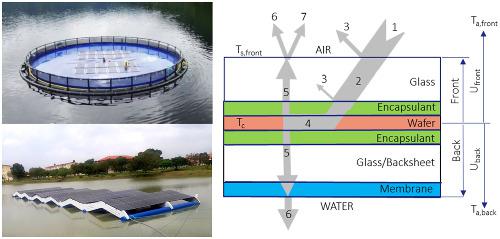当前位置:
X-MOL 学术
›
Prog. Photovoltaics
›
论文详情
Our official English website, www.x-mol.net, welcomes your
feedback! (Note: you will need to create a separate account there.)
Heat loss coefficients computed for floating PV modules
Progress in Photovoltaics ( IF 8.0 ) Pub Date : 2021-07-27 , DOI: 10.1002/pip.3451 Dag Lindholm 1 , Torunn Kjeldstad 2 , Josefine Selj 2 , Erik Stensrud Marstein 2 , Hallvard Gustav Fjær 1
Progress in Photovoltaics ( IF 8.0 ) Pub Date : 2021-07-27 , DOI: 10.1002/pip.3451 Dag Lindholm 1 , Torunn Kjeldstad 2 , Josefine Selj 2 , Erik Stensrud Marstein 2 , Hallvard Gustav Fjær 1
Affiliation

|
For floating PV (FPV), the operating temperature of the PV modules has been a major source of uncertainty. As the operating temperature of PV modules affects their efficiency, knowledge of this parameter is critical in order to perform accurate energy yield assessment (EYA). This uncertainty is reflected in the scientific literature but has also hampered the bankability and realization of commercial FPV projects. Our work proposes a model that computes both the efficiency of heat loss to the environment for a given FPV technology and the operational cell temperature, needed to compute the module efficiency. The suggested model is applicable to different FPV technologies. We show that PV modules that are not in direct thermal contact with water have similar heat loss behavior as land-based PV. We thereafter investigate a specific technology in which the modules are mounted on a membrane resting directly on the water body. The model is validated against actual production and weather data from deployed FPV systems. Our results show that the water temperature impacts both FPV technologies, however to a smaller degree for the air-cooled system, where the wind is of greater influence. When in direct thermal contact with water, the water body provides superior cooling, and the resulting U-value of about 86.5 W/m2K is significantly larger than typical values reported for land-based modules.
中文翻译:

为浮动光伏组件计算的热损失系数
对于浮动光伏 (FPV),光伏组件的工作温度一直是不确定性的主要来源。由于光伏组件的工作温度会影响其效率,因此了解此参数对于执行准确的能量产量评估 (EYA) 至关重要。这种不确定性反映在科学文献中,但也阻碍了商业 FPV 项目的可融资性和实现。我们的工作提出了一个模型,该模型计算给定 FPV 技术的环境热损失效率和计算模块效率所需的工作电池温度。建议的模型适用于不同的 FPV 技术。我们表明,不与水直接热接触的光伏模块具有与陆基光伏相似的热损失行为。此后,我们研究了一种特定技术,其中模块安装在直接位于水体上的膜上。该模型根据来自部署的 FPV 系统的实际生产和天气数据进行了验证。我们的结果表明,水温对两种 FPV 技术都有影响,但对风冷系统影响较小,风的影响更大。当与水直接热接触时,水体提供卓越的冷却,产生的 U 值约为 86.5 W/m2 K 明显大于陆基模块报告的典型值。
更新日期:2021-07-27
中文翻译:

为浮动光伏组件计算的热损失系数
对于浮动光伏 (FPV),光伏组件的工作温度一直是不确定性的主要来源。由于光伏组件的工作温度会影响其效率,因此了解此参数对于执行准确的能量产量评估 (EYA) 至关重要。这种不确定性反映在科学文献中,但也阻碍了商业 FPV 项目的可融资性和实现。我们的工作提出了一个模型,该模型计算给定 FPV 技术的环境热损失效率和计算模块效率所需的工作电池温度。建议的模型适用于不同的 FPV 技术。我们表明,不与水直接热接触的光伏模块具有与陆基光伏相似的热损失行为。此后,我们研究了一种特定技术,其中模块安装在直接位于水体上的膜上。该模型根据来自部署的 FPV 系统的实际生产和天气数据进行了验证。我们的结果表明,水温对两种 FPV 技术都有影响,但对风冷系统影响较小,风的影响更大。当与水直接热接触时,水体提供卓越的冷却,产生的 U 值约为 86.5 W/m2 K 明显大于陆基模块报告的典型值。











































 京公网安备 11010802027423号
京公网安备 11010802027423号